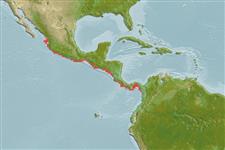Actinopterígios (peces con aletas radiadas) >
Ophidiiformes (Cusk eels) >
Bythitidae (Viviparous brotulas) > Brosmophycinae
Etymology: Ogilbia: Taken from Ogilby, 1887-1915, icthiologist and zoologist (Ref. 45335); sedorae: Named for Dr. Allegra Noelle Sedor.. More on author: Schwarzhans, Nielsen.
Medioambiente / Clima / Gama
Ecología
; marino asociado a arrecife; rango de profundidad 0 - 15 m (Ref. 57883). Tropical, preferred ?; 23°N - 6°N (Ref. 57883)
Eastern Pacific: off Colombia to the Gulf of Panama in the south; off Mazatlan, southern Sinaloa province, Mexico, in the north. So far not recorded from the region in between.
Tamaño / Peso / Age
Maturity: Lm ? range ? - ? cm
Max length : 5.9 cm SL macho / no sexado; (Ref. 57883)
Short description
Morfología | Morfometría
Radios blandos dorsales (total): 63-73; Radios blandos anales: 47 - 54; Vértebra: 38 - 41. The species is distinguished by the following: Vertebrae 11-12 + 27-30 = 38-41, dorsal fin rays 63-73, anal fin rays 47-54, outer pseudoclasper very slender, long, wing-shaped, slightly expanded posterodistally, and with single, almost straight supporter; inner pseudoclasper long, stalked, distally with three branches, anterior branch curved, median branch stout, posterior branch fleshy ear-lobed flap; penis tapering; opercular spine with single, sharp tip in
small specimens and furcated (2-3 tips) in specimens greater than 45 mm SL; scale patch on cheeks with 7-8 vertical scale rows; otolith length: height ratio 2.4-2.5 (Ref. 57883).
Inhabits coral and rocky reefs. A 5.9 cm SL female (USNM 263738) contains about 60 eggs, 0.4-0.6 mm in diameter and 140 embryos, 4-5 mm TL, with 2 rows of 2-3 large spots along anal and dorsal fin bases (Ref. 57883).
Life cycle and mating behavior
Madurez | Reproducción | Puesta | Huevos | Fecundidad | Larva
Møller, P.R., W. Schwarzhans and J.G. Nielsen, 2005. Review of the American Dinematichthyini (Teleostei: Bythitidae). Part II. Ogilbia. Aqua J. Ichthyol. Aquat. Biol. 10(4):133-207. (Ref. 57883)
IUCN Red List Status (Ref. 115185)
CITES (Ref. 94142)
Not Evaluated
Threat to humans
Harmless
Human uses
Más información
Age/SizeCrecimientoLength-weightLength-lengthLength-frequenciesMorfometríaMorfologíaLarvaDinámica larvariaReclutamientoAbundancia
ReferenciasAcuiculturaPerfil de acuiculturaRazasGenéticaFrecuencias de alelosheritabilidadEnfermedadesProcesamientoMass conversion
ColaboradoresImágenesStamps, CoinsSonidosCiguateraVelocidadTipo de nataciónSuperficie branquialOtolitosCerebrosVisión
Herramientas
Special reports
Download XML
Fuentes de Internet
